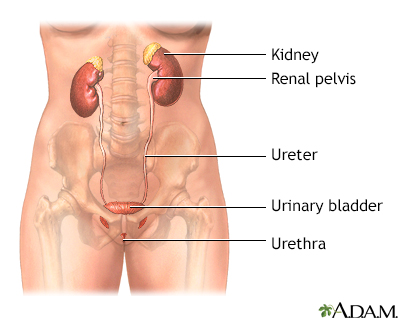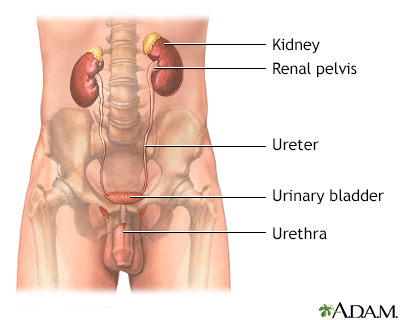Urinary incontinence products - self-care
If you have problems with urinary incontinence (leakage), wearing special products will keep you dry and help you avoid embarrassing situations.
Urinary incontinence
Urinary (or bladder) incontinence occurs when you are not able to keep urine from leaking out of your urethra. The urethra is the tube that carries ...

Urinary incontinence - Animation
When you enter a store or restaurant, are you often looking to find the establishments bathroom? If you're having trouble holding in your urine, or if you often leak urine, you probably have what's called urinary incontinence. Normally, the bladder begins to fill with urine from the kidneys. The bladder stretches to allow more and more urine. You should feel the first urge to urinate when there is about 200 mL, just under 1 cup of urine stored in your bladder. A healthy nervous system will respond to this stretching sensation by letting you know that you have to urinate. But, at the same time, the bladder should keep filling. But the system doesn't work correctly in people with urinary incontinence. Some people with urinary incontinence leak urine during activities like coughing, sneezing, laughing, or exercise. This is called stress incontinence. When you have a sudden, strong need to urinate, but can't make it to the bathroom before you do urinate, it's called urge incontinence. Other people have what's called overflow incontinence, when the bladder cannot empty and they dribble. Urinary incontinence can have many causes, and it's most common in older adults. Women are more likely than men to have it. For some people the bladder muscle is overactive. For others, the muscles holding the urine in are weak. And for others, the problem is sensing when the bladder is full. They might have brain or nerve problems, dementia or other health problems that make it hard to feel and respond to the urge to urinate, or problems with the urinary system itself. To treat urinary incontinence, your doctor can help you form a treatment plan. Most likely, exercises to strengthen the muscles of your pelvic floor will be part of that plan. Bladder training exercises can also be effective. And depending on the cause of incontinence, oral medications, or topical estrogen may be helpful. If you have overflow incontinence and cannot empty your bladder completely, you may need to use a catheter. Your doctor can recommend the best catheter for you. For urine leaks, you might wear absorbent pads or undergarments. Whatever else you try, lifestyle changes may help. Aim for an ideal weight. Losing excess weight and increasing exercise both often improve incontinence, especially in women. Also, some specific beverages and foods might increase leaking in some people. For instance, you might try eliminating alcohol, caffeine, carbonated beverages, even decaf coffee. Drink plenty of water, but do NOT drink anything 2 to 4 hours before going to bed. Be sure to empty your bladder before going to bed to help prevent urine leakage at night. Throughout the day, urinate at set times, even if you do not feel the urge. Schedule yourself every 3 to 4 hours. Urinary incontinence is very common, but many people never talk to their doctor about it. Don't let that be you. See your doctor and bring it up at your next doctor's visit.
Choosing the Right Product
First, talk with your health care provider to make sure the cause of your leakage and your treatment options. Urinary incontinence products can be used with these treatments.
There are many types of urinary incontinence products that you can buy. These products help keep your skin dry and prevent skin rashes and sores.
Urinary incontinence products
There are many products to help you manage urinary incontinence. You can decide which product to choose based on:How much urine you loseComfortCostD...

Ask your provider which product might be best for you. It depends on how much leakage you have and when it happens. You might also be concerned about cost, odor control, comfort, and how easy the product is to use.
You can always try another product if the one you are using is uncomfortable or does not keep you dry enough.
Your provider might ask you to drink less fluid throughout the day to cut down on leakage. Your provider may also recommend using the bathroom at regular, set times to help avoid accidents. Keeping a journal about when you have leakage problems can help your provider treat you.
Products for Men and Women
You can wear disposable pads in your underwear. They have a waterproof backing that keeps your clothes from getting wet. Common brands are:
- Attends
- Abena
- Depends
- Poise
- Reassure
- Serenity
- Tena
- Tranquility
- Many different store brands
Always change your pad or underwear regularly, even if you are dry. Changing often will keep your skin healthy. Set aside time to change 2 to 4 times a day at the same times every day.
Adult Diapers and Underwear
You can use adult diapers if you are leaking large amounts of urine. You can buy the kind that you use once and throw away, or ones that you can wash and reuse. They come in different sizes. Wear a size that fits you snugly. Some have elastic around the legs to keep from leaking onto your clothes. Some come with a plastic cover for more protection.
Special, washable underwear are also available. These look more like regular underwear than adult diapers. Some have a waterproof crotch area and room for a pad or liner. Some are made out of a special waterproof fabric that keeps your skin dry. You do not need a pad with these.
Waterproof outer pants made of nylon, vinyl, or rubber are also available. They can be worn over your underwear.
Special Products for Men
Men can use a drip collector for small amounts of urine leakage. This is a small pocket that fits over the penis. Wear close-fitting underwear to keep it in place.
Men can also use a condom catheter device. It fits over the penis like a condom. A tube carries the urine that collects in it to a bag attached to the leg. This helps to prevent odor and skin problems.
Special Products for Women
Women can try different products, depending on the cause for their urine leakage. External devices include:
- Foam pads that are very small and fit between your labia. You take the pad out when you need to urinate, and then put a new one in. Common brands are UroMed and Impressa.
- A urethra cap is a silicone cap, or shield that fits in place over your urinary opening. It can be washed and used again. Common brands are CapSure and FemAssist.
Internal devices to prevent urine leakage include:
- A single-use plastic shaft that can be inserted into your urethra (hole where urine comes out) and has a balloon on one end and a tab on the other. It is only for single, short-term use and needs to be removed to urinate. Common brands are Reliance and FemSoft.
- A pessary is a round latex or silicone disk that is inserted into your vagina to provide bladder support. It needs to be removed and washed on a regular basis. It must be fitted and prescribed by your provider.
Products to Protect Your Furniture
You can buy special waterproof pads to put under your sheets and on your chairs. Sometimes these are called Chux or blue pads. Some pads are washable and can be reused. Others you use once and throw away.
You can also create your own pad from a vinyl tablecloth or shower curtain lining.
Where to Buy Products
Many of these products are available over-the-counter (without a prescription) at your local drugstore or supermarket. You might have to check a medical supply store or search online for some products.
Remember, washable items may help save money.
Your insurance may pay for your pads and other incontinence supplies if you have prescription from your provider. Check with your insurance company to find out.
When to Call the Doctor
Contact your provider if:
- You are not sure how to use your product.
- You are not staying dry.
- You develop a skin rash or sores.
Skin rash
Rashes involve changes in the color, feeling or texture of your skin.
 ImageRead Article Now Book Mark Article
ImageRead Article Now Book Mark Article - You have signs of infection (a burning sensation when you urinate, fever, or chills).
Burning sensation when you urinate
Painful urination is any pain, discomfort, or burning sensation when passing urine.
 ImageRead Article Now Book Mark Article
ImageRead Article Now Book Mark ArticleFever
Fever is the temporary increase in the body's temperature in response to a disease or illness. A child has a fever when the temperature is at or abov...
 ImageRead Article Now Book Mark Article
ImageRead Article Now Book Mark ArticleChills
Chills refers to feeling cold after being in a cold environment. The word can also refer to an episode of shivering along with paleness and feeling ...
 ImageRead Article Now Book Mark Article
ImageRead Article Now Book Mark Article
Reviewed By
Kelly L. Stratton, MD, FACS, Associate Professor, Department of Urology, University of Oklahoma Health Sciences Center, Oklahoma City, OK. Also reviewed by David C. Dugdale, MD, Medical Director, Brenda Conaway, Editorial Director, and the A.D.A.M. Editorial team.
Boone TB, Stewart JN, Martinez LM. Additional therapies for storage and emptying failure. In: Partin AW, Dmochowski RR, Kavoussi LR, Peters CA, eds. Campbell-Walsh-Wein Urology. 12th ed. Philadelphia, PA: Elsevier; 2021:chap 127.
Griebling TL. Aging and geriatric urologoy. In: Partin AW, Dmochowski RR, Kavoussi LR, Peters CA, eds. Campbell-Walsh-Wein Urology. 12th ed. Philadelphia, PA: Elsevier; 2021:chap 128.
Newman DK, Burgio KL. Conservative management of urinary incontinence: behavioral and pelvic floor therapy and urethral and pelvic devices. In: Partin AW, Dmochowski RR, Kavoussi LR, Peters CA, eds. Campbell-Walsh-Wein Urology. 12th ed. Philadelphia, PA: Elsevier; 2021:chap 121.
Resnick NM, DuBeau CE. Urinary incontinence. In: Goldman L, Schafer AI, eds. Goldman-Cecil Medicine. 27th ed. Philadelphia, PA: Elsevier; 2024:chap 115.



 All rights reserved.
All rights reserved.